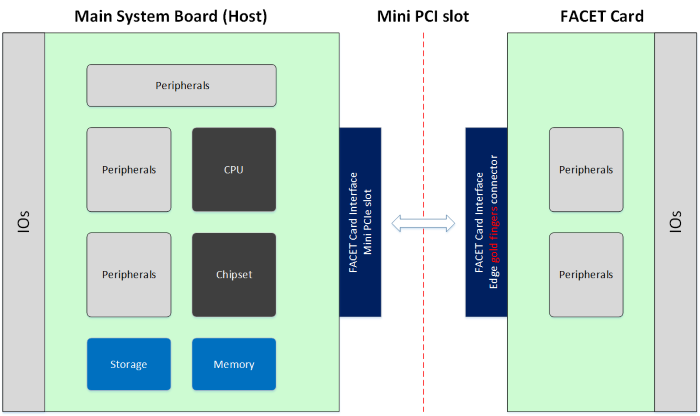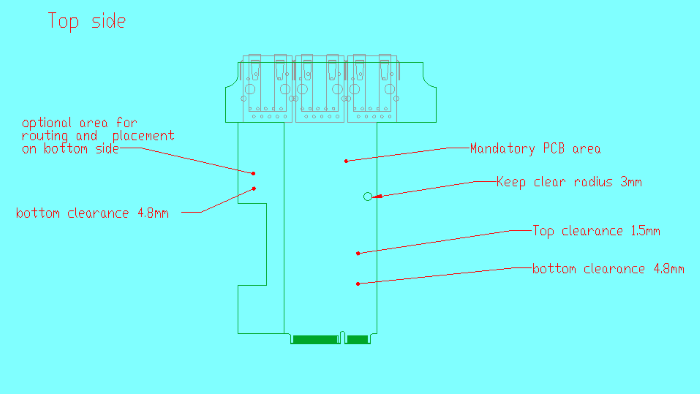Fitlet1 FACET Cards
Contents
Concept
FACET Cards are implemented with internal T-shaped extension board. The extension board is connected to already available motherboard’s mini PCI Express slot, featuring standard PC interfaces such as PCIe, USB2, SMBus and LPC Bus.
FACET Card Electrical Interface
FACET Card interface based on regular mini PCI Express interface featuring extended signals and functionality, as legacy LPC Bus interface and additional PCI Express lanes.
fitlet mini PCI Express edge connector pinout
| fitlet mini PCI Express edge connector | |||||
|---|---|---|---|---|---|
| Pin # | Pin Name | Signal Description | Pin # | Pin Name | Signal Description |
| 1 | WAKE# | Open drain, active low signal driven low by a mini PCIe card to reactivate the PCIe link | 2 | 3.3Vaux | 3.3V power rail |
| 3 | PERn2 | PCI Express Gen2 differential receive pair 2 | 4 | GND | Ground connection |
| 5 | PERp2 | 6 | 1.5V | 1.5V power rail | |
| 7 | CLKREQ# | Clock request - open drain, active low driven by mini PCIe card to request PCIe reference clock | 8 | LAD0 | LPC Bus Data signals |
| 9 | GND | Ground connection | 10 | LAD1 | |
| 11 | REFCLK- | Reference clock used to assist the synchronization of PCI Express interface timing circuits | 12 | LAD2 | |
| 13 | REFCLK+ | 14 | LAD3 | ||
| 15 | GND | Ground connection | 16 | LFRAME# | LPC Bus frame signal. Active Low |
| Mechanical Notch Key | |||||
| 17 | PETn2 | PCI Express Gen2 differential receive pair 2 | 18 | GND | Ground connection |
| 19 | PETp2 | 20 | W_DISABLE# | Active low signal when asserted by the system disable radio operation. Reserved for future use. | |
| 21 | GND | Ground connection | 22 | PERST# | Asserted when power is switched off and also can be used by the system to force HW reset |
| 23 | PERn0 | PCI Express differential receive pair | 24 | 3.3Vaux | 3.3V power rail |
| 25 | PERp0 | 26 | GND | Ground connection | |
| 27 | GND | Ground connection | 28 | 1.5V | 1.5V power rail |
| 29 | GND | Ground connection | 30 | SMB_CLK | Optional SMBus two-wire interface for Host/mini PCIe module communication |
| 31 | PETn0 | PCI Express differential transmit pair | 32 | SMB_DATA | |
| 33 | PETp0 | 34 | GND | Ground connection | |
| 35 | GND | Ground connection | 36 | USB_D- | USB Host Interface |
| 37 | LPC_CLK0 | LPC Bus clock | 38 | USB_D+ | |
| 39 | 3.3Vaux | 3.3V power rail | 40 | GND | Ground connection |
| 41 | 3.3Vaux | 3.3V power rail | 42 | LED_WWAN# / LPC_SMI# | Active low output signals are provided to allow status indications to users via system provided LEDs (or LPC Bus control signals) |
| 43 | PETn1 | PCI Express Gen2 differential transmit pair 1 | 44 | LED_WLAN# / LPC_PME# | |
| 45 | PETp1 | 46 | LED_WPAN# / SERIRQ | ||
| 47 | LPC_RST# | LPC Bus Reset signal. Active Low | 48 | 1.5V | 1.5V power rail |
| 49 | PERn1 | PCI Express Gen2 differential receive pair 1 | 50 | GND | Ground connection |
| 51 | PERp1 | 52 | 3.3Vaux | 3.3V power rail | |
FACET Card Mechanical Interface
FACET interface based on a standard mini PCI express connection, both electrical and mechanical, therefore standard layout guidelines apply for FACET mechanical design. PCB shape of custom FACET derived from fitlet-X PCB design, mechanical stack-up and other mechanical constraints, shown in the DXF file below.
FACET PCB design should meet mini PCI Express design guidelines in terms of edge connector design (hard gold fingers), PCB thickness, other parameters, and follow general recommendations described in PCI express mini card electromechanical specification 1.2.
Extended Functionality
PCI Express Interface Fitlet-X SoC provides several PCI Express Root Ports, supporting the PCI Express Base Specification, Revision 2.0. Each Root Port lane supports up to 5 Gbps bandwidth in each direction (10 Gbps concurrent). FACET PCI Express interface consist of 3x PCI Express gen2.0 lanes.
LPC Bus Interface The Low Pin Count (LPC) bus interface is a cost-efficient, low-speed interface designed to support low-speed legacy (ISA, X-bus) devices. The LPC interface essentially eliminates the need of ISA and X-bus in the system. Here the ISA bus is internal to SoC and is used for connecting to the legacy Direct Memory Access (DMA) logic. The LPC host controller is integrated into the SoC. It connects to the internal A-Link bus on one side and the LPC and Serial Peripheral Interface (SPI) buses on the other side. The ISA interface is only used for legacy DMA operation. Examples of LPC devices include Super I/O (disk controller, keyboard controller), BIOS RAM, audio, Trusted Platform Module (TPM), and system management controller. LPC host controller has the A-Link bus on one side and the LPC bus on the other. The host controller supports memory and I/O read/write, DMA read/write, and bus master memory I/O read/write. It supports up to two bus masters and seven DMA channels

